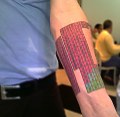
Where online do you turn, when you are looking for a periodic table?
The domain name PeriodicTable.com – reveals a superb online periodic table with an obvious website name and the option to buy a poster printout.
For more on what Periodic Tables mean and their underlying formulations check out Periodic Table Formulations by Mark Leach
Berkeley nuclear chemist Mitch Garcia who runs ChemicalForums.com, would, as would many other chemists turn straight to Mark Winter’s Web Elements this seminal online PT has become the guide to elemental discoveries and has been in existence almost beyond living memory (in net-years). However, he also points out that there is more nuclearcentric PT on the Lawrence Berkeley Lab site that provides all the decay properties for all the isotopes.
An interactive PT aimed squarely at NMR spectroscopists is offered here and with a click tells you how many isotopes for each element and whether or not it is NMR active. A click of the arrow then spells out the spin, abundance, quadrupolar moment, and typical relaxation time information.
If you are after pretty PT, then the slightly overblown version from the Royal Society of Chemistry is nice enough at Visual Elements.
A single site offering a conventional PT in six different languages (English, Dutch, French, German, Italian, Spanish) can be found at LennTech.com.
The American Chemical Society has an interactive PT, although I’m not entirely sure what makes it any more interactive than any of the others. It too is available in different languages, however, including Chinese, English, French, German, Japanese, Russian, and Spanish.
On the other hand, there is something about the Dynamic Periodic Table that gives it the edge on the word interactive in that there are various sliders and tabs that allow you to alter the way the Table is displayed depending on the elemental properties you wish to study. It is even available in Swahili for those chemists south of the Sahara.
It was inevitable that I’d have to mention the ubiquitous Wikipedia, which under the chemical jurisdiction of Martin Walker also provides a straightforward PT for the masses. In fact my good friend Michael Engel and several other practicing chemists point out that they invariably stop off at Wiki for elemental information and if that fails simply Google what they’re after to find the data.
If you are looking for yet another interactive periodic table, then try this one from designers TouchSpin. Originally, it was referred to as portable, perhaps it could be saved to your PC or a USB stick, but there seem to be no references to this now. Anyway, a much more obvious way to make a PT portable is simply to print it (colour or b&w), what you gain in tangibility you lose in interactivity of course.
If you want interactivity and portability then the Periodic Library will slip into a tiny space on your Windows hard drive taking up a mere 264 kilobytes or thereabouts. The website shows a PDA in its iconography but doesn’t specifically mention a PDA version.
To combine your penchant for coffee table books with your love of periodic tables turn to the infamously offline wooden periodic table, which is not only a period piece by definition but metaphysically the absolute zenith in coffee table information repositories.
A rather staid but internationally renowned PT is that found on the IUPAC website. Given that IUPAC ultimately decides on the names of the elements this has to be the place to go for absolute elemental knowledge.
Anything but staid, is the real cutting edge in online periodic tables, the Second Life PT from Andrew Lang and Jean-Claude Bradley [no relation] of Drexel University sponsored by ACS.
There are, of course, hundreds if not thousands of variations on the Periodic Table theme, many of them cranky beyond belief, others tailored for specific groups of scientists such as physicists and geologists, others in 3D that attempt to show more information than conventional flat Tables, and yet others that are not so much PTs as simply entertaining. The obviously named AllPeriodicTables.com provides yet more information and conventional online version of the interactive PT. This one has an environmental bent.
For more on the philosophy underlying the periodic table take a look at the work of Eric Scerri.
If you’re interested in how the chemical elements were named, then this etymology of all the elements is rather useful.
If I’ve overlooked an online periodic table you find particularly useful in your research field let me know in the comments.



